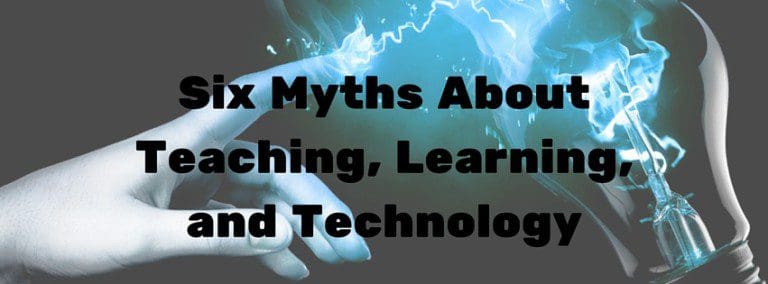How we can keep
false assumptions
from driving our thinking
A major hurdle to improving education is the fact that so many people think they know what’s wrong with it. After all, every one of us was a student at one time. Compounding the problem is the reality that American students generally perform poorly on international assessments. When people like Bill Gates lament, “When traveling abroad, I am terrified of our workforce of tomorrow,” business leaders and politicians take notice.
For decades, formal education has consisted of three main ingredients: Teaching, curriculum, and assessment. A fourth ingredient—technology—is a relative newcomer to the mix. However, the rapid spread of digital technology has raised its perceived importance in the reform arena. Some educators believe if these ingredients are standardized, schools will produce high-achieving students. In our race to be number one, six myths have undermined the ability to raise the bar as high as some would hope.
Returning to the “glory days”
of schooling would be
far from glorious.
The first myth: Schooling should be restored to its former glory. Certainly our system is not perfect. However, it wasn’t perfect in the past either. Over-reliance on rote learning limited students’ thinking. While repetition and memorization have a place on the academic continuum, these strategies should not dominate it. Literacy rates among every segment of the population have risen from thirty years ago. It might be argued that our educational system was well matched to our social and economic needs at one time; but those times have long passed. Returning to these days would be far from glorious.
The second myth: 21st century learning is the end all be all. Sixteen years into the 21st century, we are still talking as if the century hasn’t turned. Unfortunately, the term has been used to the point of confusion. The 4C’s are often used to describe the essential features of 21st century learning—critical thinking, communication, collaboration, and creativity. Yet, others say it’s much broader than that. They believe a deeper sense of awareness and responsibility is what will make students globally ready. No matter how your school board envisions 21st century learning, the real impact occurs when the entire district works toward the same vision. Rather than argue over the definition of 21st century learning, we better serve our students when we define what an educated person should know and be able to do upon leaving our high schools.
Teachers, not devices, have
the greatest influence on
how students view themselves.
The third myth: Technology will replace the teacher. While technology continues to change the role a teacher plays in the classroom, there is little reason to believe it will eliminate the need for human interaction. Technology can replace some of the things teachers do. However, it is the teacher, not a device, who has the greatest influence on how students see themselves and the world. Teachers change the trajectory of students’ lives through their relationships with students and the way they nurture learning.
The fourth myth: New teachers are more inclined to use technology than older teachers. Studies of college students have found that although young people understand how to access technology, much of their use is for entertainment and social purposes. To be digitally literate, new teachers often need more coaching and practice with online collaboration and embedding technology within their lesson design. Unfortunately, many universities are behind the times in making technology integration part of required coursework.
The fifth myth: Flipped classrooms provide more personalized learning. In flipped classrooms, online videos are used to deliver lectures outside class time so the teacher can spend in-class time on more important skills (e.g., application, collaboration, inquiry). However, the flipped class model often is more about the teacher providing individualized guidance during class than creating a platform for personalized learning.
The sixth myth: Virtual learning is a more efficient instructional model. While virtual platforms may be a good way to deliver content, they don’t necessarily allow students to engage in content in ways that lead to deeper understanding. Say a high school class is gearing up to participate in a live underwater video conference on the construction of coral reefs. Pre- and post-activities must be developed by the teacher. Training has to be undertaken to ensure the teacher is comfortable using the technology. In fact, preparation for a virtual lesson can take three to ten times longer than it takes to plan a traditional lesson. Many teachers feel the benefits don’t outweigh the time to support effective application.
The wise board knows
that innovation cannot
be standardized.
The wise board knows that innovation cannot be standardized. It’s better for a student to be taught by an effective teacher using an outdated textbook than to be taught by an ineffective teacher using the latest and greatest technology. Of course, the best combination of teacher skills, tools, and strategies to support learning will lead to the best outcomes.
After the launch of Sputnik, dozens of initiatives were introduced in our schools. Yet, these initiatives weren’t what got us to the moon. It was a compelling vision that inspired the call to action. People developed the skills to make the vision a reality and believed in the reasons for doing it. Resources were provided to get the job done. A sound plan was established to implement changes along the way. Without alignment among these core elements—vision, skills, resources, and a sound plan of action—myths will continue to drive our thinking in schools.



